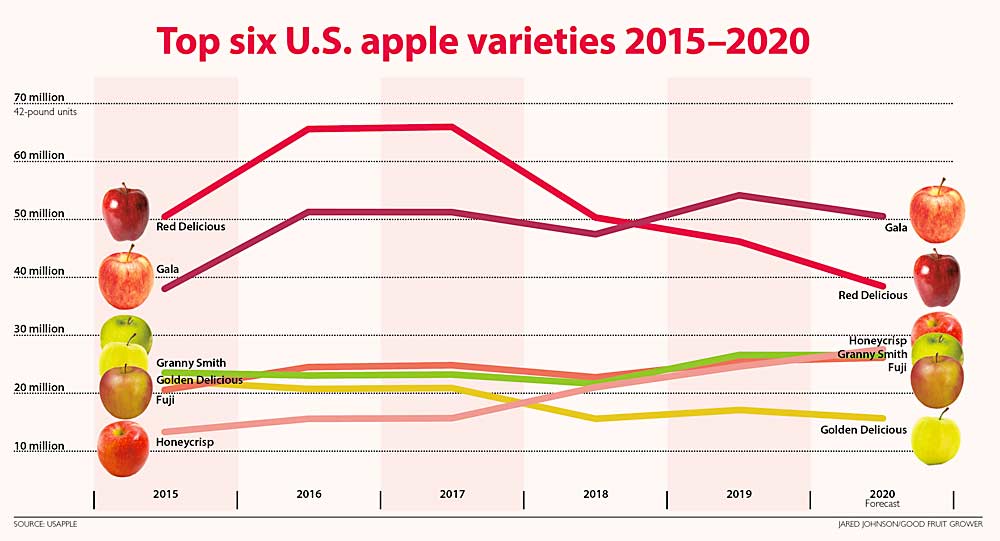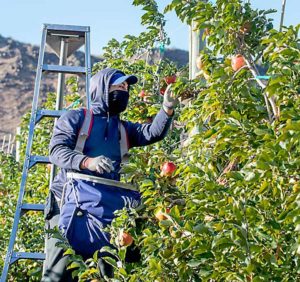
Graph: Jared Johnson/Good Fruit Grower)
The United States will produce 253.3 million bushels of apples in 2020, according to the U.S. Apple Association.
That will be down 3 percent from 2019 and down 2 percent from the five-year average. USApple’s Aug. 21 estimate aligns with the estimate made by the U.S. Department of Agriculture on Aug. 12, which was 253.5 million bushels.
The Western states will produce 186.5 million bushels, down 3 percent from last year but up 5 percent from the five-year average.
—Washington, as usual, will lead the way with 176 million bushels, down
3 percent from last year but up 5 percent from the five-year average.
—California will produce 6.4 million bushels, down 11 percent from 2019 but up 8 percent from the five-year average.
—Oregon will produce 3.8 million bushels, up 9 percent from 2019 and the same as the five-year average.
The Eastern states will produce 44.3 million bushels, down 8 percent from last year and down 9 percent from the five-year average.
—New York will lead the way with 32 million bushels, up 2 percent from last year and up 1 percent from the five-year average.
—Pennsylvania will produce 8.5 million bushels, down 30 percent from 2019 and down 41 percent from the five-year average.
—Virginia will produce 3.8 million bushels, down 16 percent from last year and down 25 percent from the five-year average.
The Midwest, where Michigan is the only state counted, will produce 22.5 million bushels, same as 2019 but down 9 percent from the five-year average.
Varieties
Gala was officially the top variety in 2019, with 54 million bushels produced, followed by Red Delicious with 46 million bushels. Granny Smith, Fuji and Honeycrisp rounded out the top five. Honeycrisp is forecast to be the No. 3 variety in 2020, with 27.6 million bushels. The top five varieties comprise 67 percent of all apple production.
Cosmic Crisp, the new apple from Washington state, is starting to make its mark, with 467,000 bushels in 2019 and 2.1 million bushels estimated for 2020 (which would put it in the top 15), according to USApple.
International estimates
Mexico will produce 19.8 million boxes of apples in 2020, according to estimates shared at the USApple conference, down from 26 million boxes in 2019 — one of the country’s largest crops ever. The state of Chihuahua will produce 18.5 million boxes, with Coahuila, Durango and Puebla supplying the rest.
Canada will produce 18.7 million bushels of apples, up 3.5 percent from 2019. Ontario will supply 7.3 million of those bushels, down 2 percent from last year; Quebec will supply 5.5 million, up 6 percent from last year.
McIntosh, at 4.6 million bushels, is still the top variety in Canada but is down to 24.6 percent of the crop, whereas it was 35.4 percent five years ago. Gala, at 3.3 million bushels, is No. 2 with 17.6 percent of the crop. Ambrosia is up to 2.1 million bushels, and Honeycrisp is up to 1.7 million bushels.
Despite a cold snap in western growing provinces and heavy rains in others, China expects a 2020 apple crop of 40 million metric tons (one metric ton is roughly equivalent to 52 42-pound bushels), down 5.7 percent from 2019. Though it’s the world’s largest apple producer, only a small percentage of China’s crop is exported, mostly to Southeast Asian countries.
For South America, the World Apple and Pear Association estimated that Chile will produce 1.5 million metric tons of apples in 2020, Brazil 1.1 million metric tons and Argentina 550,000 metric tons.
Europe will produce 10.7 million metric tons of apples in 2020, a crop1 percent smaller than 2019 and 7 percent smaller than the five-year average. The top three producers will be Poland (3.4 million metric tons), Italy (2 million) and France (1.4 million). Golden Delicious, still the top variety in Europe, will be just below 2 million metric tons, down 13 percent from last year. Gala, at 1.5 million metric tons, is up 4 percent from last year. Organic apples, at 511,000 metric tons, are getting close to 5 percent of total European production.
As for neighboring countries, Turkey will produce 3.7 million metric tons, Ukraine 1.2 million and Russia 920,000.
—by Matt Milkovich







Leave A Comment